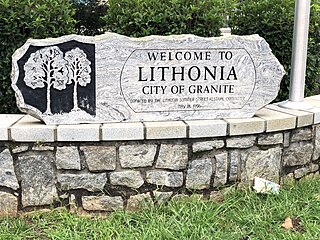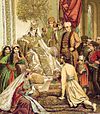
Lithonia is a city in eastern DeKalb County, Georgia, United States. The city's population was 1,924 at the 2010 census. Lithonia is in the Atlanta metropolitan area.

Alexander Hamilton Stephens was an American politician who served as the only Vice President of the Confederate States from 1861 to 1865, and later as the 50th Governor of Georgia from 1882 until his death in 1883. A member of the Democratic Party, Stephens represented the state of Georgia in the United States House of Representatives prior to becoming Governor.

The President of Georgia is the constitutional Head of State of Georgia as well as the Supreme Commander-in-Chief of the Defense Forces. They represent Georgia in foreign relations. The constitution defines the presidential office as "the guarantor of the country’s unity and national independence."

The flag of Georgia, also known as the Five Cross Flag, is one of the national symbols of Georgia. Originally a banner of the medieval Kingdom of Georgia, it was brought back to popular use in the late 20th and early 21st centuries during periods of the Georgian national revival. Prior to obtaining its official status in 2004, the flag was popularized by the United National Movement and served as one of the most recognisable symbols of the Rose Revolution.

Zugdidi is a city in the Western Georgian historical province of Samegrelo (Mingrelia). It is situated in the north-west of that province. The city is located 318 kilometres west of Tbilisi, 30 km from the Black Sea coast and 30 km from the Egrisi Range, at an elevation of 100–110 metres above sea level. Zugdidi is the capital of the Samegrelo-Zemo Svaneti region, which combines Samegrelo (Mingrelia) and upper part of Svaneti, and the center of the Zugdidi Municipality within.
General Ramsey Muir Withers, CMM, CD was a Canadian Army Officer and Chief of the Defence Staff, the highest ranking position in the Canadian Forces, from 1980-1983. He died of a heart attack in 2014.

Last Holiday is a 2006 American romantic comedy-drama film directed by Wayne Wang and written by Jeffrey Price and Peter S. Seaman. Loosely based on the 1950 British film of the same name by J. B. Priestley, the film stars Queen Latifah as Georgia, a humble store assistant who is told that she has a rare brain condition to which only a few weeks to live. She promptly decides to spend her last funds on a luxury holiday in Europe before she dies.

Jvari is a town in the northwestern Georgian province of Samegrelo-Zemo Svaneti. The town is situated at an altitude of 280 metres near the Magana River where it flows into the Enguri River; The town is divided in two with "Jvari" lying on the Zugdidi-Mestia highway, and Jvarzeni up the hill.

Dedoplistskaro or Dedoplistsqaro is a town in Kakheti, Georgia with the population of 5,940. The town is located in the Shiraki Plain, eastern Georgia, and functions as a municipality of the eponymous district.

Abastumani is a small town (daba) and climatic spa in Adigeni Municipality, Samtskhe-Javakheti, Georgia. It is located on the southern slopes of the Meskheti Range, in the small river valley of Otskhe, 25 km northeast of Adigeni and 28 km west of Akhaltsikhe. As of the 2014 census, it had a population of 937. The Georgian National Astrophysical Observatory is located at Abastumani.
Vardan I Dadiani was a Georgian noble and the forefather of the Dadiani, the princely dynasty of Samegrelo (Mingrelia), a region in western Georgia which Vardan ruled as eristavi ("duke") from 1183 to 1213. He was a prominent courtier of Queen Tamar of Georgia, but fell out of favor after leading an abortive rebellion in support of Tamar's disgraced former husband George the Rus' in 1191.
Zakaria II Mkhargrdzeli or Zakare Zakarian was a Georgian–Armenian noble and one of the generals of Queen Tamar of Georgia army during the late 12th and early 13th centuries. He was the ruler of feudal lands in the Kingdom of Georgia.

The Georgian Golden Age describes a historical period in the High Middle Ages, spanning from roughly the late 11th to 13th centuries, during which the Kingdom of Georgia reached the peak of its power and development. In addition to military expansion, this period saw the flourishing of medieval Georgian architecture, painting and poetry, which was frequently expressed in the development of ecclesiastic art, as well as the creation of first major works of secular literature.
Anton Gnolistavisdze was a 12th-century Georgian politician and monk.
Anton Sagirisdze or Anton Kutateli was a 12th century Georgian archbishop of Kutaisi.
Chiaber was a Georgian noble (didebuli) from eastern Georgia in 12th century. A foster son of George III of Georgia.
Gamrekeli Toreli or Gamrekeli of Tori was a 12th-century Georgian noble (didebuli) and duke (eristavi) of Akhalkalakhi and Tori.
Abulasan was a 12th-century Georgian politician, who served as mayor of Tbilisi and Eristavi of Kartli (1185–1188).














